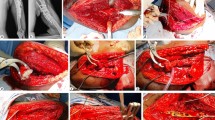Abstract
Aim
The aim of this study was to evaluate nonunion causes of surgically treated humeral shaft fractures in two different trauma centers.
Methods
A total of 327 cases of humeral shaft fractures were treated in 11 years in two trauma centers. We retrospectively reviewed in detail some factors in order to understand the reasons for nonunion: (1) fracture type, according to the AO classification, (2) grade of open fracture, according to Gustilo–Anderson, (3) timing, (4) reduction and (5) fixation.
Results
We observed 19 nonunions, 10 women and 9 men, with an average age of 57 years. Fractures were 1 A1 case, 2 A2 cases, 4 B2 cases, 6 B3 cases, 2 C1 cases, 1 C2 case and 3 C3 cases. Three cases had a simple fracture with two fragments; all the other were comminuted. Fifteen cases were closed, four open. The major criticalities observed were fracture comminution, exposure, unstable fixation and bone resorption. All 19 patients with nonunion underwent surgical fixation with compression plate and frozen cortical bone graft. A 4.5 LCP plate was used in 17 cases. The remaining 2 cases had an anatomical site-specific proximal humeral 3.5-mm LCP plate (Synthes, Paoli, PA, USA). In 17 patients, the nonunion healed: 15 cases treated with a 4.5 straight plate, and 2 cases with an anatomical site-specific proximal humeral 3.5 mm LCP plate, at a mean of 5 months. In 2 cases, consolidation was not reached.
Conclusions
We believe that humeral diaphyseal fractures should be treated surgically to avoid many complications. Our retrospective analysis indicates that factors that lead to a fixation failure are fracture comminution, open fracture, unstable fixation. The 19 nonunions treated with compression plating and frozen bone graft demonstrated consolidation in almost 90% of the cases.



Similar content being viewed by others
References
Bell MJ, Beauchamp CG, Kellam JK, McMurray RY (1985) The results of plating humeral shaft fractures in patients with multiple injuries. The Sunnybrook experience. J Bone Jt Surg Br 67(2):293–296
Brinker MR, O’Connor DP (2004) The incidence of fractures and dislocations referred for orthopaedic services in a capitated population. J Bone Jt Surg Am 86:290–297
Tytherleigh-Strong G, Walls N, McQueen MM (1998) The epidemiology of humeral shaft fractures. J Bone Jt Surg Br 80:249–253
Healy WL, White GM, Mick CA, Brooker AF Jr, Weiland AJ (1987) Nonunion of the humeral shaft. Clin Orthop Relat Res 219:206–213
Ruedi T, Mosfegh A, Pfeiffer KM et al (1974) Fresh fractures of the shaft of the humerus. Conservative or operative treatment? Reconstr Surg Traumatol 14:65
Ring D, Chin K, Taghinia AH et al (2007) Nonunion after functional brace treatment of diaphyseal humerus fractures. J Trauma 62:1157–1158
Waqllny T, Westermann K, Sagebiel C et al (1997) Functional treatment of humeral shaft fractures: indications and results. J Orthop Trauma 11:283–287
Ilyas I, Younge DA (2003) Locked intramedullary nailing for difficult nonunions of the humeral diaphysis. Int Orthop 27(5):278–281
Lin J, Hou S-M, Hang Y-S (2000) Treatment of humeral shaft delayed unions and nonunions with humeral locked nails. J Trauma Inj Infect Crit Care 48(4):695–703
Stern PJ, Mattingly DA, Pomeroy DL, Zenni EJ, Kreig JK (1984) Intramedullary fixation of humeral shaft fractures. J Bone Jt Surg Am 66:639–646
Rj Foster, Dixon GL, Bach AW, Appleyard RW, Green TM (1985) Internal fixation of fractures and nonunions of the humeral shaft. J Bone Jt Surg Am 67:857–864
Padhye KP, Kulkarni VS, Kulkarni GS, Kulkarni MG, Kulkarni S, Kulkarni R et al (2013) Plating, nailing, external fixation and fibular strut grafting for nonunion of humeral shaft fractures. J Orthop Surg 21(3):327–331
Wagner M, Frenk A, Frigg R (2004) New concepts for bone fracture treatment and the locking compression plate. Surg Technol Int 12:271–277
Ring D, Perey BH, Jupiter JB (1999) The functional outcome of operative treatment of ununited fractures of the humeral diaphysis in older patients. J Bone Jt Surg 81:177–190
Singh AK, Arun GR, Narsaria N, Srivastava A (2014) Treatment of non-union of humerus diaphyseal fractures: a prospective study comparing interlocking nail and locking compression plate. Arch Orthop Trauma Surg 134:947–953
Peters MR, Claessen FMAP, Doornberg JN, Kolovich GP, Diercks RL, Van den Bekerom MPJ (2015) Union rate after operative treatment of humeral shaft nonunion. A systematic review. Inj Int J Care Inj 46:2314
King AR, Moran SL, Steinmann SP (2007) Humeral nonunion. Hand Clin 23(4):449–456
Prasarn ML, Achor T, Paul O, Lorich DG, Helfet DL (2010) Management of nonunions of the proximal humeral diaphysis. Inj Int J Care Inj 41:1244–1248
Ring D, Gullotta L, Jupiter JB (2003) Unstable nonunions of the distal part of the humerus. J Bone Jt Surg Am 85(6):1040–1046
Pascarella R, Ponziani L, Ferri M, Ercolani C, Zinghi GF (2000) Aseptci nonunion of the humeral shaft. Chir Organ Mov 85(1):29–34
Gustilo RB, Anderson JT (1976) Prevention of infection in the treatment of one-thousand and twenty-five open fractures of long bones: retrospective and prospective analysis. J Bone Jt Surg Am 58:453–458
Hierholzer C, Sama D, Toro JB, Peterson M, Helfet DL (2006) Plate fixation of ununited humeral shaft fractures: effect of type of bone graft on healing. J Bone Jt Surg Am 88:1442–1447
Hornicek FJ, Zych GA, Hutson JJ, Malinin TI (2001) Salvage of humeral nonunions with only bone plate allograft augmentation. Clin Orthop Relat Res 386:203–209
Van Houwelingen AP, McKee MD (2005) Treatment of osteopenic humeral shaft nonunion with compression plating, humeral cortical allograft struts, and bone grafting. J Orthop Trauma 19:36–42
Author information
Authors and Affiliations
Corresponding author
Ethics declarations
Conflict of interest
None.
Rights and permissions
About this article
Cite this article
Maresca, A., Sangiovanni, P., Cerbasi, S. et al. Why a surgically treated humeral shaft fracture became a nonunion: review of 11 years in two trauma centers. Musculoskelet Surg 101 (Suppl 2), 105–112 (2017). https://doi.org/10.1007/s12306-017-0509-5
Received:
Accepted:
Published:
Issue Date:
DOI: https://doi.org/10.1007/s12306-017-0509-5




